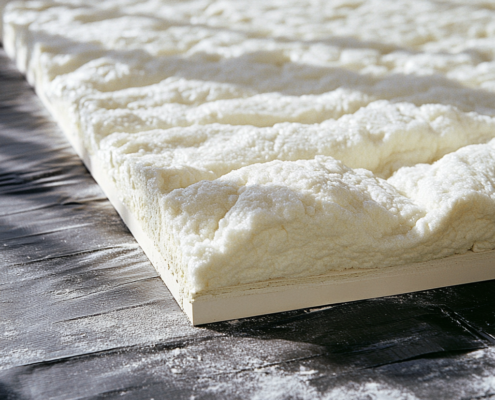What is Flat Roof Insulation?
If you’re building or renovating a home with a flat roof, understanding how to properly insulate it is essential. Insulating a flat roof can be trickier than insulating a pitched roof, but with the right approach, you can boost your home’s energy efficiency and save on heating and cooling costs. In this guide, we’ll explore two popular ways to insulate a flat roof: cold roof and warm roof insulation. By the end, you’ll know which option is best for your home.
Flat roof insulation helps keep your home comfortable year-round. It reduces heat loss in winter and keeps the inside cool during the summer. By properly insulating your flat roof, you can lower energy bills and improve comfort. There are two main types of flat roof insulation: cold roof insulation (installed inside the home) and warm roof insulation (installed outside the home). The type you choose depends on your climate, budget, and building regulations.
Cold Roof vs. Warm Roof: Which is Better for Your Home?
Here’s a simple breakdown of both types of flat roof insulation:
Cold Roof Insulation (Internal)
- How it works: Insulation is installed beneath the roof structure, between the ceiling joists inside your home.
- Why choose it: It’s usually more affordable, and it’s easier to add to an existing roof.
- Downside: There’s a higher chance of condensation and mold buildup, so regular inspections are important.
Warm Roof Insulation (External)
- How it works: Insulation is placed above the roof decking, under the waterproof membrane.
- Why choose it: This method offers better energy efficiency, reduces condensation risk, and lasts longer.
- Downside: It’s more expensive and may require professional installation.
How to Insulate a Flat Roof from the Inside (Cold Roof Insulation)
Cold roof insulation is an affordable way to insulate your flat roof. Follow these simple steps for effective insulation:
Step 1: Gather Materials
You’ll need:
- Rigid foam or fiberglass insulation boards
- Vapor barrier or foil-backed insulation
- Measuring tape
- Utility knife or saw for cutting insulation
- Adhesive or fasteners
Step 2: Clear the Area
Before installing, clear the area of any old insulation and debris. Measure the space between the joists to ensure a snug fit for your insulation.
Step 3: Install the Insulation
Cut the insulation boards to fit between the joists. Leave a small gap (about 50-60mm) between the insulation and roof decking for ventilation. This gap helps prevent condensation.
Step 4: Add a Vapor Barrier
Install a vapor barrier over the insulation to keep moisture from affecting the material. You can use foil-backed insulation or a vapor-resistant membrane.
Step 5: Secure the Insulation
Use adhesive or fasteners to keep the insulation and vapor barrier in place. If your joists are shallow, spray foam insulation may provide better coverage.
Pro Tip: Cold roof insulation is prone to condensation, so regularly inspect it for moisture or mold buildup.
How to Insulate a Flat Roof from the Outside (Warm Roof Insulation)
Warm roof insulation is a more efficient method for insulating a flat roof, though it’s typically more expensive. Here’s how to do it:
Step 1: Prepare the Roof and Materials
You’ll need:
- Insulation boards (rigid foam, PIR, or EPS)
- Primer and waterproofing membrane
- Roofing screws and fasteners
Clean the roof surface thoroughly before starting. Apply a primer if needed to help the waterproofing membrane stick better.
Step 2: Install Insulation Boards
Lay the insulation boards directly on the roof decking, fitting them tightly together. Use high-density boards like polyisocyanurate (PIR) for the best thermal protection.
Step 3: Secure the Insulation
Fasten the insulation boards with roofing screws or fasteners. Make sure they are spaced evenly for stability.
Step 4: Apply the Waterproof Membrane
Once the insulation is secured, apply a waterproof membrane (EPDM, TPO, or modified bitumen) over the entire roof to prevent water damage.
Step 5: Add a Finishing Layer
You can finish your roof with a reflective coating or gravel. This layer improves energy efficiency and extends the life of your roof.
Pro Tip: Warm roof insulation can last up to 25 years with proper care, making it a good long-term investment.
Cold vs. Warm Roof Insulation: A Quick Comparison
| Insulation Type | Pros | Cons |
|---|---|---|
| Cold Roof | – Affordable – Easier to install – Suitable for existing roofs |
– Higher risk of condensation – May need extra ventilation |
| Warm Roof | – Superior energy efficiency – Lower condensation risk – Longer lifespan |
– More expensive – Requires professional installation |
Additional Tips for Improving Flat Roof Insulation
Looking to boost your roof’s performance even more? Try these techniques:
- Reflective Coatings
In warmer climates, applying a reflective coating to your roof can lower cooling costs. These coatings reflect sunlight and keep the roof cooler. - Green Roofs
A green roof with plants on the surface can provide natural insulation. This eco-friendly solution also reduces the heat island effect in cities. - Inverted Roof Insulation
This method places insulation above the waterproofing membrane, providing extra protection from the sun and weather. It’s durable and common in commercial buildings.
Commonly Asked Questions About Flat Roof Insulation
Q: Which type of insulation is better for colder climates?
A: Warm roof insulation works best for cold climates because it provides superior thermal protection and reduces heat loss.
Q: How often should flat roof insulation be checked?
A: Inspect your roof insulation once a year, especially after severe weather, to look for damage or moisture buildup.
Q: Can I install flat roof insulation myself?
A: You can install cold roof insulation yourself, but warm roof insulation is best left to professionals due to its complexity.
Q: What is the lifespan of flat roof insulation?
A: Cold roof insulation can last 10-15 years, while warm roof insulation can last 25 years or more with proper maintenance.
Next Steps: Ready to Insulate Your Flat Roof?
Whether you’re choosing cold roof insulation for its affordability or warm roof insulation for maximum energy efficiency, proper installation is key to long-lasting results. If you’re unsure which method is right for your home, consider consulting a professional roofing company like CommercialFlatRoofs.ca. They can help you make the best decision for your needs.
Explore related articles on Deckrite or check out DeckriteCanada.com for more tips on enhancing your home’s roofing system.








